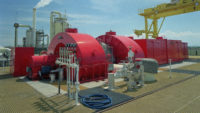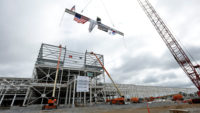A $500-million grant program is set to help pay for energy upgrade projects for U.S. public schools, Vice President Kamala Harris announced April 4, with funds coming from the $1.2-trillion Infrastructure Investment and Jobs Act.
The U.S. Dept. of Energy grants will be available to public schools for projects that result in reduced energy costs, such as improvements to lighting and HVAC systems. Funding can also be used for repairs and renovations that improve student and teacher health.
The energy efficiency program is part of the Biden administration’s aim to reach a net-zero emissions economy by 2050, while also providing savings to schools on one of their largest costs. According to the White House, energy bills are the largest expense for public K-12 districts after teacher salaries, collectively costing them about $8 billion each year.
Stan Kolbe, executive director of legislative and political affairs for the Sheet Metal and Air Conditioning Contractors' National Association (SMACNA), says the program is poised to have far-reaching impacts and shows a change in Congress' willingness to fund school projects.
“Go back 30 years, you couldn’t pass a bill with a penny for school facilities,” says Kolbe. “Now we’re talking about how many billions it could be.”
Aging school buildings that still use radiators, lack HVAC and have windows painted shut could be upgraded with central air systems, modern ductwork and proper filtration under the program, Kolbe says. These changes would also improve overall air quality in the schools, which he adds has become a greater concern since the start of the COVID-19 pandemic.
DOE has issued a request for information for the program and will accept responses through May 18. The RFI seeks input on questions about how the agency will administer the grant program, such as determining prioritization criteria and how it can support workforce development.
Kolbe says he expects the funds will roll out to schools quickly, and schools will want to move fast in order to get a piece of the money. He points to the Paycheck Protection Program, which ran out of money faster than expected.
“If you’re a school contractor, you might want to say, ‘Remember me? I did the school five years ago,’ or, ‘I service the school, I can certainly do the retrofit,’” Kolbe says. “Because I think this is going to happen real soon.”
The program is part of a larger Biden administration initiative to improve school infrastructure.
On its 2021 infrastructure report card, the American Society of Civil Engineers rated U.S. public schools a D+, pointing to data showing many face capacity issues while also needing to replace one or more building systems. ASCE estimates there is a $38-billion annual funding gap for public school facilities nationally.
“Children should be able to learn and grow in environments that are not plagued with poor insulation and ventilation, leaky roofs, or poor heating and cooling,” U.S. Energy Secretary Jennifer Granholm said in a statement. DOE is also offering loan guarantees up to $3 billion for school retrofit projects through its new eProject eXpress tool.
Other pieces of the initiative include a U.S. Treasury Dept. effort to to help districts use American Rescue Plan funds for air quality improvements. The U.S. Environmental Protection Agency and DOE are working on a $5-billion Clean School Bus Program, also funded by the infrastructure act, to help school districts use electric buses. The U.S. Dept. of Transportation is also providing $90 billion for state and local governments to help students walk or bike to school.
By adding federal funding for these programs, the added effect is that school districts will be relieved of the cost burdens, Kolbe says.
“It’s pretty much a home run of a list of initiatives we’ve been talking about for probably 25 years,” he says.






Post a comment to this article
Report Abusive Comment